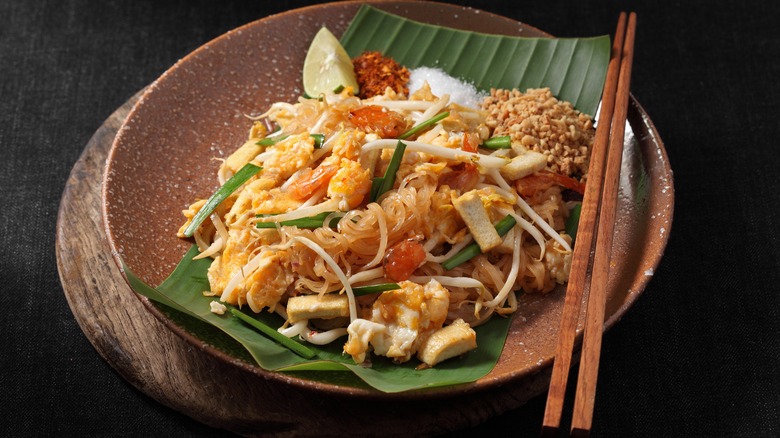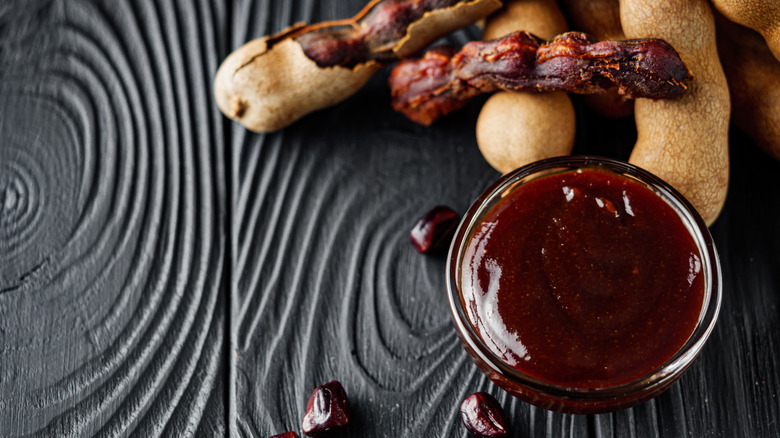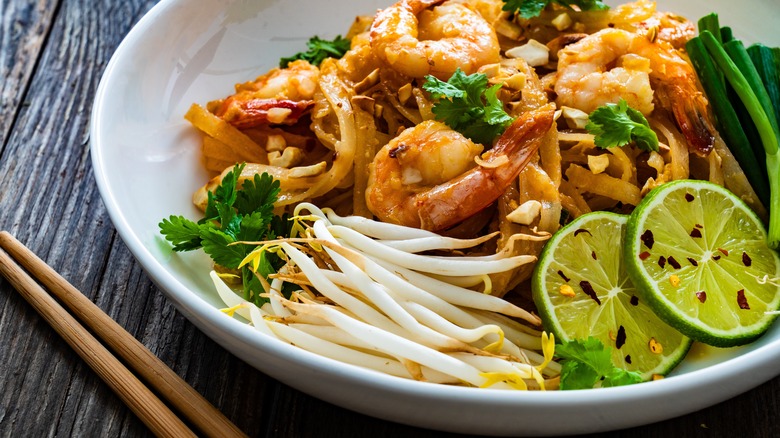The Best Pad Thai Hinges On This Special Pantry Ingredient
Picture Thai cuisine, and a few dishes likely come to mind: mango sticky rice, perhaps a Thai basil beef recipe, and almost certainly a portion of pad Thai. A takeout favorite in the U.S., this dish was actually only created and popularized by the Thai government in the 1940s. The creation is a fusion of cuisines, employing a Chinese stir-frying technique. Yet the mix of components is quintessential Thai: rice noodles accompanied by tofu, dried shrimp, peanuts, and vegetables, all dosed in a salty, sweet, slightly spicy and sour sauce.
The resultant flavor is vibrant and complex, with many chefs noting tamarind is the essential component that ties it all together. So, to reproduce the traditional pad Thai flavor, you'll want to buy some of this ingredient. Tamarind brings tangy and slightly sweet notes that'll achieve the perfect balance of sourness in the sauce, all the while melding with other components. You'll have two principal options to purchase tamarind as a condiment; either as a pulp or concentrate. There are pros and cons to each version, but the pulp is often the preferred option for pad Thai, lending the dish the perfect pop of flavor.
Purchase tamarind pulp for the best pad Thai
Surprising due to its rich sweet-sour flavor, tamarind fruit has a dark brown color, and hails from a tree. A member of the pea family, its tasty essence is contained in a long pod, with a flavorful sticky mush covering several seeds. While delicious to eat raw, fresh tamarind is both hard to find stateside, and laborious to work with, so pad Thai cooks may need to settle on the fruit in a processed form.
Tamarind pulp, which captures the bright and zesty flavors, is a good option. The pulp consists of exclusively fruit flesh, which comes condensed in a brick. You'll find it fresh or frozen at specialty Latin American and Asian grocers, as well as online. The only con is the added manual work. You'll need to rehydrate the block in hot water, stirring to ensure the water really infiltrates into the fruit. After 30 minutes of hydration, it's necessary to sieve the mixture, which requires some effort forcing the thick paste through the mesh. Finally, the tamarind pulp will be ready to mix into a delicious pad Thai sauce, and stir fried to completion.
Tamarind combines with salty, spicy and sweet flavors in the stir fry
Although the dish is undeniably tangy, pad Thai also contains sweet, salty, and spicy ingredients. Alongside the mildly fruit tamarind notes, sugar derived from palm or coconut trees is employed. And, to make the dish quintessentially Thai, there's going to be some chilies, too. Although other dishes in the cuisine, like pad prik, are better known for their spice. And lastly, expect a dose of saltiness by way of fish sauce, which also contributes savory notes.
For the ideal pad Thai sauce, it's all about balancing such flavors, and the tamarind is the central component that ties it all together. Whether you just finished soaking the pulp, or opted for concentrate, it's the first ingredient that goes into the sauce bowl. When mixing, make sure the tamarind isn't drowned out with other additions. Then, it's time to assemble the stir fry itself, with the protein of your choice, alongside vegetables and the characteristic rice noodles to craft a mouth watering pad Thai.
And once you've perfected this recipe, experiment with the ingredient in other applications, too. After all, tamarind is the flavorful secret to Texas Roadhouse steak sauce, and it's also a component in Worcestershire sauce. So, it'll elevate plenty of other dishes with its delightful sweet and sour flavor.


